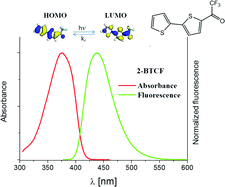Spectral characteristics of carbonyl substituted 2,2′-bithiophenes in polymer matrices and low polar solvents†
Abstract
The spectral characteristics of monosubstituted derivatives of

* Corresponding authors
a
Polymer Institute, Slovak Academy of Sciences, Dúbravská cesta 9, SK-845 41 Bratislava, Slovak Republic
E-mail:
martin.danko@savba.sk, anita.andicsova@savba.sk, Pavol.hrdlovic@savba.sk, dusan.racko@savba.sk
Fax: +421 2 3229 4319
Tel: +421 2 3229 4353
b
Department of Organic Chemistry, Slovak University of Technology, Radlinského 9, SK-812 37 Bratislava, Slovak Republic
E-mail:
daniel.vegh@stuba.sk
Fax: +421 2 5296 8560
Tel: +421 2 5932 5160
The spectral characteristics of monosubstituted derivatives of

 Please wait while we load your content...
Something went wrong. Try again?
Please wait while we load your content...
Something went wrong. Try again?
M. Danko, A. Andicsová, P. Hrdlovič, D. Račko and D. Végh, Photochem. Photobiol. Sci., 2013, 12, 1210 DOI: 10.1039/C3PP50049G
To request permission to reproduce material from this article, please go to the Copyright Clearance Center request page.
If you are an author contributing to an RSC publication, you do not need to request permission provided correct acknowledgement is given.
If you are the author of this article, you do not need to request permission to reproduce figures and diagrams provided correct acknowledgement is given. If you want to reproduce the whole article in a third-party publication (excluding your thesis/dissertation for which permission is not required) please go to the Copyright Clearance Center request page.
Read more about how to correctly acknowledge RSC content.
 Fetching data from CrossRef.
Fetching data from CrossRef.
This may take some time to load.
Loading related content
